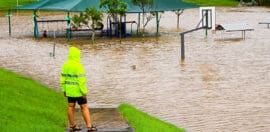What you need to know about COP27

21 November 2022 at 5:15 pm
COP27 has failed to deliver in key areas, but one headline agreement is being celebrated.
Arguably one of the most important global climate conferences so far, COP27 has now come to a close.
Reactions to the conference, held in Sharm El-Sheikh, Egypt, are mixed as news comes to light about the wranglings between countries.
For Australia, COP27 was a big deal; it was new Prime Minister Albanese’s chance to present Australia’s new attitude towards the climate crisis on the world stage, along with its new emissions reduction targets.
Australia was one of only 21 countries attending COP27 with a legislated emissions reduction target.
Australia also sought to use COP27 to bid to host COP31 in four years’ time, in conjunction with the Pacific, in what WWF said would be “an Olympic moment”.
Fight fund
The headline decision to come out of COP27 was to establish a loss and damage fund to support vulnerable countries hit by the impacts of the climate crisis.
Governments present at the conference agreed to “establish new funding arrangements, as well as a dedicated fund, to assist developing countries in responding to loss and damage”, the UN reported.
A transitional committee will be formed to recommend how to operationalise the funding arrangements and is expected to meet before the end of March 2023.
The loss and damage fund has been hailed as a victory by climate organisations around the world.
Executive director of women’s rights organisation ActionAid Australia, Michelle Higelin, called the establishment of the fund “a historic turning point”.
“This loss and damage fund is long overdue, but it is a clear demonstration of the collective power of civil society, of communities on the frontlines of the climate crisis and developing nations for forcing rich countries to finally say ‘Yes – we are in this together’,” she said.
“The fund will be a lifeline for women and girls on the frontlines of the climate crisis, whose homes, livelihoods, and ways of life are being destroyed by climate disasters, and offers communities hope that there will be a fund to help them recover and rebuild in the aftermath of disasters.”
But she said that questions remained unanswered around how the fund will be operationalised and how money will be distributed.
WWF global climate and energy lead, and COP20 president, Manuel Pulgar-Vidal, called the loss and damage fund a “positive step” but warned “it risks becoming a ‘fund for the end of the world’ if countries don’t move faster to slash emissions and limit warming to below 1.5°C”.
Less progress elsewhere
In other areas, COP27 was underwhelming.
Writing for The Conversation, Associate Professor of International Relations at the University of Queensland, Matt McDonald, said besides the headline loss and damage fund commitment, “other developments were less promising”.
“Temperature trajectories make it increasingly challenging for the world to limit temperature rises to 1.5℃. And the fact [that] keeping this commitment in Egypt was a hard-won fight casts some doubt on the global commitment to mitigation. China in particular had questioned whether the 1.5℃ target was worth retaining, and this became a key contest in the talks,” he wrote.
There was also no new commitment to phasing out fossil fuels, something that had been flagged at COP26 in Glasgow last year.
New rules on greenwashing also didn’t eventuate, he added, and Bloomberg reported there was “no reference to global greenhouse gas emissions peaking by 2025” in the conference’s final statement.
WWF’s Pulgar-Vidal said the failure to agree to phase out fossil fuels was a missed chance to accelerate their elimination and avoid catastrophic climate change.
“Without rapid and deep emissions cuts we cannot limit the scale of loss and damage,” he said.
“We cannot afford to have another climate summit like this one. It is unacceptable that negotiators have failed to reach a more ambitious agreement than that agreed in Glasgow last year. Future COP presidencies can’t squander the opportunity.
“Now governments must redouble their efforts to reduce emissions and take the necessary transformative action to keep warming to below 1.5°C. The COP28 climate summit next year must be the COP of climate credibility. And countries must deliver.”
Global lead on climate justice at ActionAid, Teresa Anderson, said polluters had been “let off the hook with COP27’s weak language on fossil fuels”.
“Climate-vulnerable communities who have been given hope through the establishing of a loss and damage fund are still being harmed by the actions of big polluters, and the underlying cause of the climate crisis has not been addressed,” she said.
In another win, more countries signed up for the Global Methane Pledge during COP27. The pledge was launched at COP26.
But crucially, the top two methane emitters — China and India — did not sign up.
Clean coal claims alleged to be false
The close of COP27 comes as independent Andrew Wilkie unveils allegations that the coal industry has been falsifying data to make Australia’s coal look cleaner than it actually is.
The ABC reported Wilkie told Parliament that these actions “allowed [coal companies] to claim, for years, that Australian coal is cleaner than it is, in order to boost profits and prevent rejection of shipments at their destination”.
He called for the government to launch an inquiry into the activities, a push that is supported by the Australian Conservation Foundation (ACF).
“This should spell an end to Australian politicians – including Prime Minister Albanese – perpetuating the myth that Australian coal is somehow cleaner than coal from elsewhere,” said ACF CEO Kelly O’Shanassy.
“There’s no such thing as ‘cleaner coal’ and it’s taken a brave whistleblower to reveal the extent of the deceptions coal companies have engaged in to increase their profits and try to hide the true nature of their dirty product.
“This raises big questions about the way coal is tested and analysed in Australian laboratories – questions that should be investigated by a parliamentary inquiry. How many Australian coal companies are involved in this scandal? What are the climate implications if more dirty Australian coal is being burned overseas? What are the health implications for people in China, India, South Korea and Japan – countries that buy Australian coal under the misapprehension that it burns cleaner than it does?
“To be a leader on climate action Australia needs to continue with the energy transition here at home and stop selling coal and gas to be burned in other countries,” she said.







